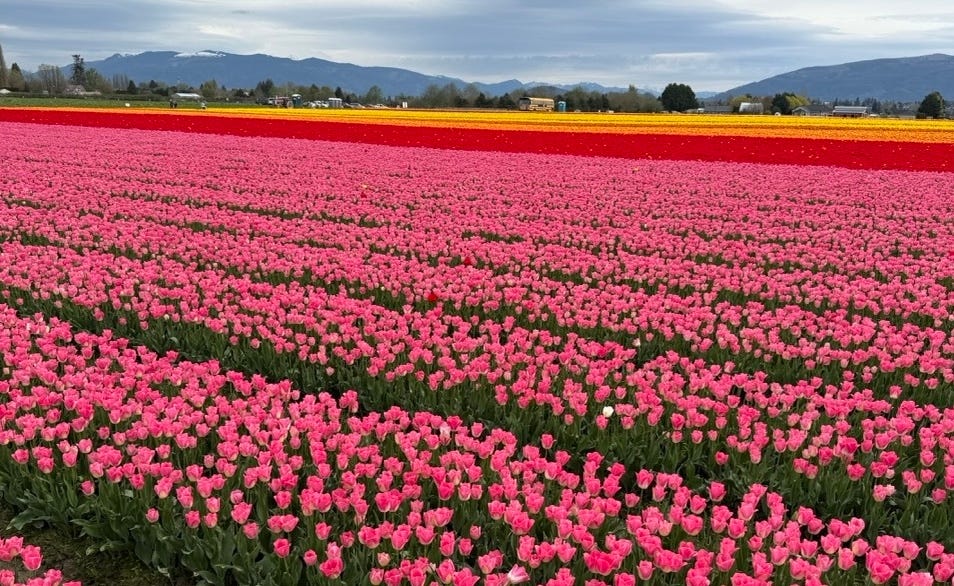Keep Farming Flowers?
A long-standing free-trade agreement between the U.S. and several South American countries encouraged farmers to grow legitimate crops instead of, say, coca, the source of cocaine.
Earlier this month, I went to the Skagit Valley Tulip Festival.
Ever see three million tulips at once?
Three million tulips is more than the eye can see, and far more flowers than in just this one picture. But “three million bulbs” was what an employee at RoozenGaarde — one of the many tulip growers participating in the festival — told me they had planted that year. And that’s never mind what was growing inside the RoozenGaarde greenhouses, which was not open to visitors. (The Dutch word RoozenGaarde, by the way, means “rose garden.”)
While visiting RoozenGaarde, I had hoped to ask a few questions about the sustainability of the operation, especially the 16 acres of greenhouses they have.
I was forthcoming about the focus and purpose of my questions, having identified myself as a journalist. But I kept getting turned away or re-directed back to the same people who would turn me away again.
The costs related to year-round flower growing operations have been well-documented by journalists reporting for the BBC and DW, for example. Those two outlets looked particularly at Royal FloraHolland. Holland is at about the same latitude as Washington’s Skagit Valley, which — from the fields I saw — seems just about perfect for growing tulips outside in the springtime. But, as the BBC and DW journalists discovered, the heating/lighting of greenhouses in the Netherlands to grow roses emits more than five times the amount of greenhouse gas emissions than growing roses in Kenya and flying them to Europe. That figure is according to research commissioned by the Fairtrade Foundation, which states “The high greenhouse gas emissions of the roses from the Netherlands are due to the combustion of natural gas for heating the greenhouses.” For Kenyan roses, “transport causes most greenhouse gas emissions.”
A note about terminology: greenhouse gas emissions does not refer to gases emitted by greenhouses such as RoozenGaarde. It’s an unfortunate choice of terms, but greenhouse gas emissions refers instead to the release of gases into the atmosphere that trap heat — such as methane and carbon dioxide — and so contribute to the greenhouse effect in the Earth’s atmosphere, warming our planet.
According to the same research study, even growing roses in Ecuador and flying them to Europe — a distance of six-thousand miles — produces far fewer greenhouse gas emissions than growing roses in the greenhouses in the Netherlands. Ecuador is much closer to the U.S.. So I was curious about the energy source powering Skagit Valley’s RoozenGaarde greenhouses. Skagit Valley generally gets its electricity from Puget Sound Energy, which has a self-reported diversified mix of sources, including natural gas (30%), hydroelectricity (30%), wind (22%), and coal (18%). But I was turned away from RoozenGaarde, repeatedly, and never got even that simple question of “how do you power your greenhouses” answered.
Understanding better the balance sheet of U.S. producers — such as RoozenGaarde — would have helped in thinking through another curiosity I have: What level of U.S. tariffs start to encourage farmers in Ecuador or other Andean countries to grow coca, the source of cocaine?
After all, the Andean Trade Preference Act (ATPA) was enacted in 1991 to reduce drug production, offering trade benefits to help Bolivia, Colombia, Ecuador and Peru develop and strengthen legitimate businesses, such as the cut-flower trade. In the Trade Act of 2002, the ATPA was expanded to provide duty-free access to U.S. markets for over five-thousand products and renamed the “Andean Trade Promotion and Drug Eradication Act.”
Since then, Bolivia lost its beneficiary status in 2008 after the U.S. proclaimed the country had failed to cooperate on counternarcotics efforts. The U.S. reached new free-trade agreements with Peru (2009) and Colombia (2012). But Ecuador’s benefits under the ATPA expired when the President’s authority to provide preferential duty treatment under the ATPA itself expired in 2013. It appears that Congress has not renewed the President’s authority to provide duty-free treatment under the ATPA, which is echoed by the latest report (2022) I could find from the United States International Trade Commission on the impact of the ATPA: The 2022 report says the ATPA has no impact because Congress did not renew the President’s authority back in 2013.
Given the tariffs President Trump announced from the White House’s Rose Garden — never mind the pause and modification on his supposed emergency declaration — it seems like a question worth posing.
“What level of U.S. tariffs start to encourage farmers in Ecuador or other Andean countries to grow coca, the source of cocaine?”
As I hope this post makes clear, we live in a very complex society in which it is challenging to understand cause and effect. Words and concepts mean different things to different people. What is ”sustainable” for Royal FloraHolland means “investing to be a modern and future-proof service provider” and “the continuity of our services to members, growers and buyers.” That’s likely not the same as what “sustainable” mean to a South American farmer trying to figure out which crop to grow.
What is one human-based system that you think needs to be in place — or strengthened — to maintain the long-term fortunes of the planet as a whole, including our presence?







Questions that need to be pondered. Thank you.